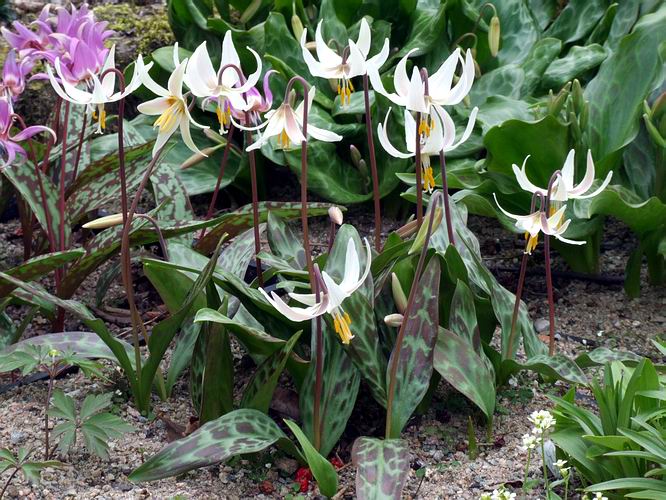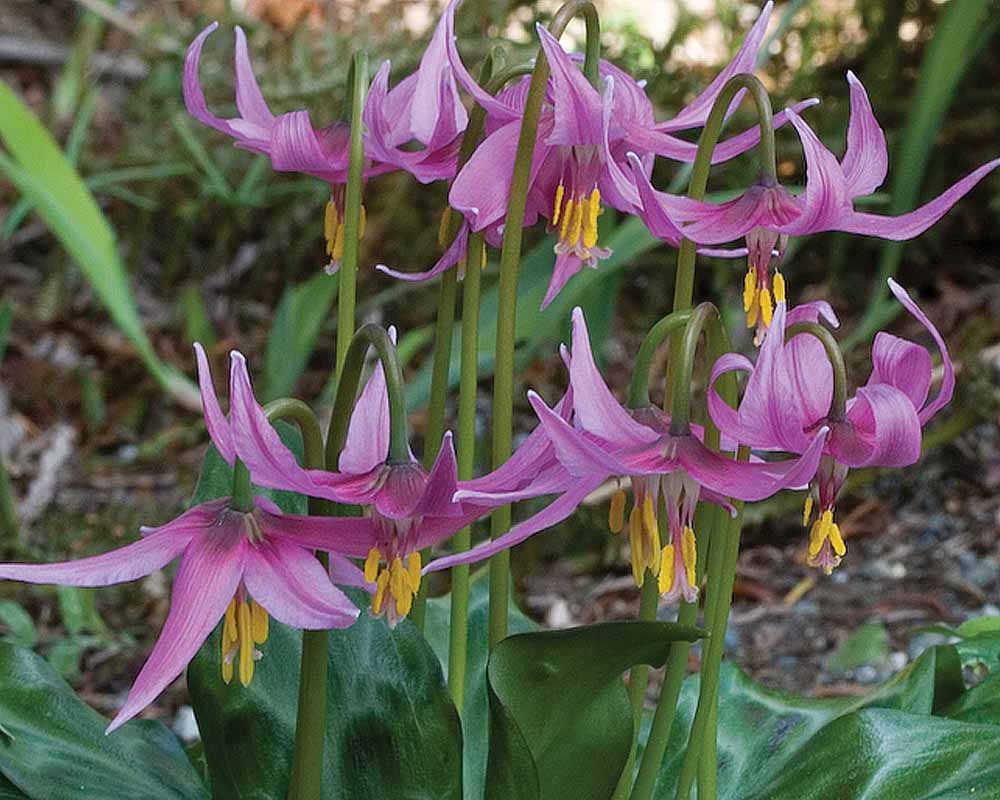Latin Name: Brunnera macrophylla
Common Name: Siberian bugloss
Family: Boraginaceae
Origin: Russia
Tree/Shrub/Herb: Herbaceous perennial
Form: Mounded
Habit: Clump forming
Buds: Alternate
Leaves: Large, puckered, mealy
Flowers: Blue, "forget-me-not" style flowers
Cultural Requirements: Wet soil, full sun to semi shade
Landscape Uses: Ground cover
Notes: Flowers in April, semi-evergreen
Latin Name: Magnolia ‘Galaxy’
Common Name: Galaxy magnolia
Family: Magnoliaceae
Origin: Garden origin
Tree/Shrub/Herb: Deciduous tree
Form: Arborescent
Habit: Broad
Leaves: Typical magnolia shape/size
Flowers: Light pink colour, many petals
Cultural Requirements: Moist, organic, well drained soil, full sun
Landscape Uses: Large space for a deciduous tree
Latin Name: Kerria japonica ‘Pleniflora’
Common Name: kerria
Family: Rosaceae
Origin: Garden origin
Tree/Shrub/Herb: Deciduous shrub
Form: Rounded
Habit: Sprawling
Leaves: Broadly triangular, sharply serrated, acute apex
Flowers: Solitary, yellow, many petals
Cultural Requirements: Moist, well-drained soil, full sun to partials shade
Landscape Uses: Colourful deciduous shrub blooming in April
Latin Name: Erythronium oregonum
Common Name: giant white fawn lily
Family: Liliaceae
Origin: Oregon
Tree/Shrub/Herb: Herbaceous perennial
Form: Flowering stalks with basal leaves
Habit: Spreading
Leaves: Basal, oblanceolate, green-purple snake-skin pattern
Flowers: Pendulous, 6 white petals, yellow stamens
Cultural Requirements: Moist, well drained soil, partial shade
Landscape Uses: Used for unique interest on an ideal site with low impact
Latin Name: Erythronium revolutum
Common Name: pink fawn lily
Family: Liliaceae
Origin: Western North America
Tree/Shrub/Herb: Herbaceous perennial
Form: Flowering stalks with basal leaves
Habit: Spreading
Leaves: Basal, oblanceolate, green-purple snake-skin pattern
Flowers: Pendulous, 6 purple petals, yellow stamens
Cultural Requirements: Moist, well drained soil, partial shade
Landscape Uses: Used for unique interest on an ideal site with low impact
Latin Name: Sedum spathulifolium
Common Name: broadleaf stonecrop
Family: Crassulaceae
Origin: Western North America
Tree/Shrub/Herb: Herbaceous perennial
Form: Prostrate
Habit: Spreading
Leaves: Juicy, succulent, delicious tasting green gobules of goodness, great in salads or on rice
Flowers: Little yellow guys, 5 petals, some sepals, goes great in a carrot soup
Cultural Requirements: Mix 2 cups cold glacial water with 1 cup of dry, nutrient poor soil. Put into a preheated full sun oven for 30 years.
Landscape Uses: Adds flavour to any plain dishes. Goes well in a goat curry.
Latin Name: Oxalis oregana
Common Name: Oregon oxalis
Family: Oxalidaceae
Origin: Oregon
Tree/Shrub/Herb: Herbaceous perennial
Form: Low, matlike
Habit: Spreading
Leaves: Compoundly tri-foliate, leaflet bi-lobed, heart shaped, leaves basal
Flowers: Small, 5 white petals with light purple inner ring, yellow stamens
Cultural Requirements: Moist, average, well drained soil, full sun to partial shade
Landscape Uses: Groundcover
Latin Name: Aubrieta x cultorum
Common Name: aubrieta
Family: Brassicaceae
Origin: Garden origin
Tree/Shrub/Herb: Herbaceous perennial
Form: Low, mounded
Habit: Matlike, spreading
Leaves: Broadly ovate, toothed, acute apex, pale green
Flowers: Purple petals with yellow stamens
Cultural Requirements: Moist, well drained soil, full sun to partial shade
Landscape Uses: Groundcover
Latin Name: Berberis darwinii
Common Name: Darwin's barberry
Family: Berberidaceae
Origin: Southern Chile and Argentina
Tree/Shrub/Herb: Evergreen shrub
Form: Oh, ya know, pretty crazy. Mounding with scary spikes.
Habit: Spreading all over the place, AHHH!
Leaves: Broadly triangular, spiny, deep green
Flowers: Cute little pendulous guys held on an infloresence of some kind
Cultural Requirements: Dry, shitty soil, somewhere that nobody cares about or ever tends to
Landscape Uses: A pokey thing to keep people away from somewhere
Latin Name: Narcissus bulbocodium
Common Name: hoop petticoat daffodil
Family: Amaryllidaceae
Origin: France, Portugal, Spain
Tree/Shrub/Herb: Herbaceous perennial
Form: Flowering stalks with basal leaves
Habit: Clump forming
Leaves: Basal, thin, linear
Flowers: Yellow, large inner whorl forming a cone, small sepals surrounding
Cultural Requirements: Moist, well-drained, organic soil in full sun to partial shade
Landscape Uses: Later spring blooming daffodil for display bed
Latin Name: Chrysosplenium davidianum
Common Name: golden saxifrage
Family: Saxifragaceae
Origin: East Asia
Tree/Shrub/Herb: Herbaceous perennial
Form: Low, matlike
Habit: Spreading
Leaves: Round leaves, serrated margin
Flowers: Yellow flowers, radially symmetric
Cultural Requirements: Wet soil, shade to semi-shade
Landscape Uses: Groundcover in a wet area
Latin Name: Dicentra formosa
Common Name: bleeding heart
Family: Papaveraceae
Origin: Western North America
Tree/Shrub/Herb: Herbaceous perennial
Form: Low, matlike
Habit: Spreading
Leaves: Deeply divided leaves, divided multiple times
Flowers: Bilaterally symmetric pink pendulous flowers
Cultural Requirements: Moist, well drained soil in woodland light conditions
Landscape Uses: Groundcover and early spring flowers in a cool area
Latin Name: Lysichiton camtschatcense
Common Name: asian skunk cabbage
Family: Araceae
Origin: Western North America
Tree/Shrub/Herb: Herbaceous perennial
Form: Basal flower stalks and shoots
Habit: Cascading from centre
Leaves: Very large, obovate
Flowers: White spathe, spadix begins green then flowers white, male florets above females
Cultural Requirements: Very wet anaerobic conditions, shade to partial shade
Landscape Uses: Native interest in wet areas
Notes: Doesn't really stink that bad
Latin Name: Magnolia stellata
Common Name: star magnolia
Family: Magnoliaceae
Origin: Japan
Tree/Shrub/Herb: Deciduous shrub
Form: Shrubby
Habit: Broad
Leaves: Typical magnolia shape/size
Flowers: White colour, about 16 tepals
Cultural Requirements: Moist, organic, well drained soil, full sun
Landscape Uses: Medium sized space for a larger shrub
Latin Name: Maianthemum dilatatum
Common Name: false lily of the valley
Family: Asparagaceae
Origin: Western North America
Tree/Shrub/Herb: Herbaceous perennial
Form: Low, matlike
Habit: Spreading
Leaves: Chordate shape, arcuate veins, basal
Flowers: Smal, white, 3 petals
Cultural Requirements: Moist, well drained soil in woodland conditions
Landscape Uses: Groundcover in cool, shady area
Latin Name: Narcissus poeticus
Common Name: poet's daffodil
Family: Amaryllidaceae
Origin: Europe
Tree/Shrub/Herb: Herbaceous perennial
Form: Flowering stalks with basal leaves
Habit: Clump forming
Leaves: Basal, thin, linear
Flowers: Dull yellow tepals, short fringed vibrant orange corona
Cultural Requirements: Moist, well-drained, organic soil in full sun to partial shade
Landscape Uses: Later spring blooming daffodil for display bed
Latin Name: Prunus ‘Tai-haku’
Common Name: Tai-haku cherry
Family: Rosaceae
Origin: Garden origin
Tree/Shrub/Herb: Deciduous tree
Form: Upright, arborescent
Habit: Broad
Leaves: Typical cherry leaves, ovate, serrated, acute apex
Flowers: Large white flowers with slight pinkish blush
Cultural Requirements: Moist, well drained soil, full sun, good air drainage
Landscape Uses: Tree for a large space
Latin Name: Symphytum ibericum
Common Name: dwarf comfrey
Family: Boraginaceae
Origin: Iberia
Tree/Shrub/Herb: Herbaceous perennial
Form: Low, matlike
Habit: Spreading aggressively
Leaves: Ovate, pointed apex, basal
Flowers: White tubular flowers
Cultural Requirements: Dry, well drained soil, partial sun
Landscape Uses: Groundcover, but be careful where it may spread
Latin Name: Trachystemon orientalis
Common Name: Oriental borage
Family: Boraginaceae
Origin: Eastern Europe
Tree/Shrub/Herb: Herbaceous perennial
Form: Basal leaves with flowering stalks
Habit: Spreading clumps
Leaves: Basal, large, ovate, chordate base, broadly acute tip
Flowers: They look like little blue/white insect heads
Cultural Requirements: Will survive in dry shade under cedar
Landscape Uses: Herbaceous planting in dry shade
Latin Name: Trillium ovatum
Common Name: pacific trillium
Family: Trilliaceae
Origin: Western North America
Tree/Shrub/Herb: Herbaceous perennial
Form: Stalks with leaves and terminal flowers
Habit: Spreading
Leaves: Trifoliate leaflets which clasp the stem
Flowers: 3 white triangular petals, 3 green sepals, 6 yellow stamens
Cultural Requirements: Shade, some sun, well drained, moist, organic soil
Landscape Uses: Herbaceous planting

















No comments:
Post a Comment